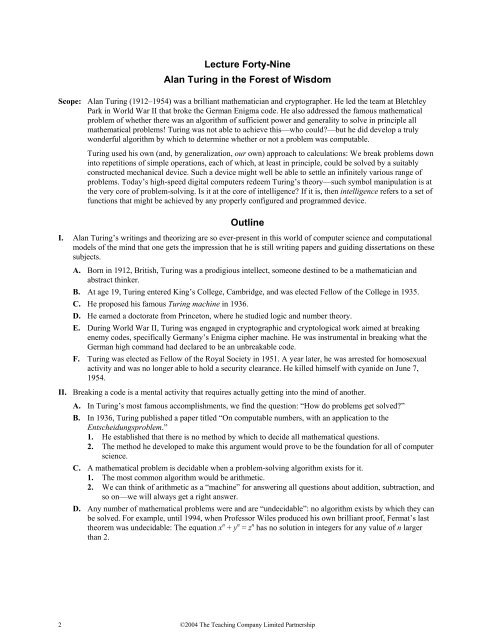Great Ideas of Philosophy
Great Ideas of Philosophy
Great Ideas of Philosophy
- No tags were found...
You also want an ePaper? Increase the reach of your titles
YUMPU automatically turns print PDFs into web optimized ePapers that Google loves.
Lecture Forty-NineAlan Turing in the Forest <strong>of</strong> WisdomScope: Alan Turing (1912–1954) was a brilliant mathematician and cryptographer. He led the team at BletchleyPark in World War II that broke the German Enigma code. He also addressed the famous mathematicalproblem <strong>of</strong> whether there was an algorithm <strong>of</strong> sufficient power and generality to solve in principle allmathematical problems! Turing was not able to achieve this—who could?—but he did develop a trulywonderful algorithm by which to determine whether or not a problem was computable.Turing used his own (and, by generalization, our own) approach to calculations: We break problems downinto repetitions <strong>of</strong> simple operations, each <strong>of</strong> which, at least in principle, could be solved by a suitablyconstructed mechanical device. Such a device might well be able to settle an infinitely various range <strong>of</strong>problems. Today’s high-speed digital computers redeem Turing’s theory—such symbol manipulation is atthe very core <strong>of</strong> problem-solving. Is it at the core <strong>of</strong> intelligence? If it is, then intelligence refers to a set <strong>of</strong>functions that might be achieved by any properly configured and programmed device.OutlineI. Alan Turing’s writings and theorizing are so ever-present in this world <strong>of</strong> computer science and computationalmodels <strong>of</strong> the mind that one gets the impression that he is still writing papers and guiding dissertations on thesesubjects.A. Born in 1912, British, Turing was a prodigious intellect, someone destined to be a mathematician andabstract thinker.B. At age 19, Turing entered King’s College, Cambridge, and was elected Fellow <strong>of</strong> the College in 1935.C. He proposed his famous Turing machine in 1936.D. He earned a doctorate from Princeton, where he studied logic and number theory.E. During World War II, Turing was engaged in cryptographic and cryptological work aimed at breakingenemy codes, specifically Germany’s Enigma cipher machine. He was instrumental in breaking what theGerman high command had declared to be an unbreakable code.F. Turing was elected as Fellow <strong>of</strong> the Royal Society in 1951. A year later, he was arrested for homosexualactivity and was no longer able to hold a security clearance. He killed himself with cyanide on June 7,1954.II. Breaking a code is a mental activity that requires actually getting into the mind <strong>of</strong> another.A. In Turing’s most famous accomplishments, we find the question: “How do problems get solved?”B. In 1936, Turing published a paper titled “On computable numbers, with an application to theEntscheidungsproblem.”1. He established that there is no method by which to decide all mathematical questions.2. The method he developed to make this argument would prove to be the foundation for all <strong>of</strong> computerscience.C. A mathematical problem is decidable when a problem-solving algorithm exists for it.1. The most common algorithm would be arithmetic.2. We can think <strong>of</strong> arithmetic as a “machine” for answering all questions about addition, subtraction, andso on—we will always get a right answer.D. Any number <strong>of</strong> mathematical problems were and are “undecidable”: no algorithm exists by which they canbe solved. For example, until 1994, when Pr<strong>of</strong>essor Wiles produced his own brilliant pro<strong>of</strong>, Fermat’s lasttheorem was undecidable: The equation x n + y n = z n has no solution in integers for any value <strong>of</strong> n largerthan 2.2©2004 The Teaching Company Limited Partnership














